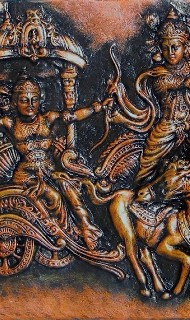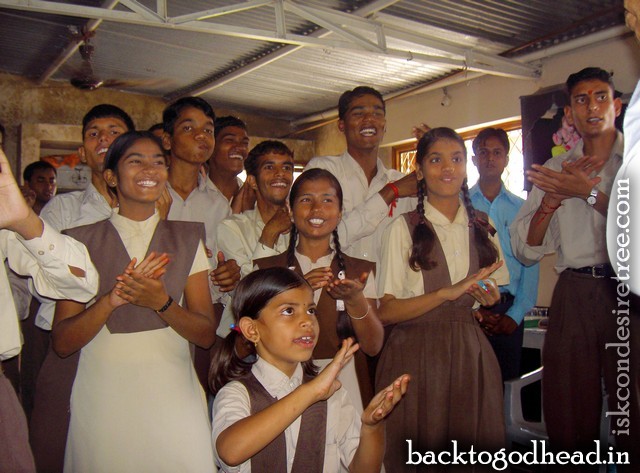
ANTAL’S CONTRIBUTION TO BHAKTI POETRY IN TAMIL LITERATURE
Dr.T.Sarada
University of wisconsin-Madison
saradabalaji@gamil.com
Abstract: This paper focuses on the contribution of Antal to the Tamil bhakti Literature. Starting with a brief introduction of bhakti is Tamil literature, the paper analyses the bhakti movement, the tenets of Vaishnavism, and the contribution of the Alvars. This short paper concentrates on certain seminal aspects Antal’s Tiruppavai, and her Nachiyar Thirumozhi. It probes into two major leitmotifs as evident in her compositions: that of the parai in Tiruppavai and the conch in the Nacciyar Tirumoli. The paper also comments upon the uniqueness of the female register in her works and the multiple diatribes that Antal had to wage in a constrictive space.
Bhakti in Tamil Literature:
Any discussion of Tamil literature would undoubtedly begin with the sangam age. Though Antal and the sangam age remain separated by several centuries, it remains crucial for us to trace the genealogy of bhakti in the annals of Tamil literature for a holistic understanding of Antal’s supreme contribution to bhakti movement.
The literature contains numerous references to a religious way of life like the vedic rites, performance of yagnas, praise of Brahmin etc. Besides, there are a plethora of references to Vishnu and Shiva. Scholars opine that these cults, existed in the pre-vedic time like those of the Indus valley civilization. A.L. Bhasham’s The Wonder that was India (1981) also illustrates the surfeit of religious references in the Indus valley civilization. Bhasham’s work is steeped in references to temples, idol-worship, worship of female-goddess, worship of sivalinga, varuna etc. The reference to Vishnu are sparse he says. At one point of time, he is said to have occupied a secondary place after Indira and was have named ‘upendra’. The flying eagle of Harappa is perceived to be a precursor of Vishnu’s garuda.
Since the focus of this paper is on Antal a Vaishnavaite poet, it would be appropriate for us to delineate the worship of the Vishnu cult in the ancient times. Seminal works like Keith’s The Religion and Philosophy of the Vedas (1998) A.A.Macdonell’s Vedic Mythology (1898) and Dhanderkar’s Vishnu in the Veda (1941) contend that Vishnu’s name is involved at least a thousand times in the Vedas, He attained a primal position in the brahmanic times. Ancient Tamil classics also display the worship of Tirumal (Vishnu), Krishna and Baldev. Dr.Subbu Reddiar has aptly pointed to the Vishnu cult in Purananooru (1000BC to 300AD). Kings were akin to Tirumal who was the protector of the universe. The Kurals 610 and 1103 also contain references to this deity. The Tamil epic Silapattikaram (2nd century AD) contains a multitude of reference to Krishna and Baladeva in the Kaviripoompattinam and Madurai. The records of Magasthenes and the famous Mathura inscription (see Subbureddiar 153) depict the primacy of Vasudeva. Gradually, the cults of Vishnu, Vasudeva and Narayana merged to form Vaishnavism. The spirit of Vaishnavism attained its high water mark during the Bhakti movement.
The Bhakti movement was essentially founded in the Southern parts of India and later spread to the north. A supremely reformist movement which was spread from the 6th to the 19th century it included within its ambit, conservatives, radicals, brahmins, sudras and women. 1 It was a concurrent diatribe against Jainism, Buddhism, brahminical and patriarchal hegemony.
Women saint poets of India attract us specially since the concept of bhakti undergoes numerous ramifications in them, While aptly delineating their dual lives – that of mundane domesticity and their surging spirits, most of the poets display the ensuing tensions and their protest against mundane shackles which impede their spiritual ascensions. While the male bhakta often questions the regular impediments that remain the common fate of humanity at large, women poets additionally question their gendered lives and gendered fates in their too familiar domestic idioms that both bind them and add a unique dimension to their poems.2 Among the South Indian women saint poets, two poets stand unique- Karikkal Ammaiyar a Shaivite saint poet and Antal the Vaishnavite saint poet. Karaikhal Ammaiyar is one among the 63 saints nayanmars who had renounced her beauteous form in lieu of ghoulish looks in order to attain union with the Lord. Her seminal compositions include the Thiruvaalangkaatu Mootha Thirupathigangal, Thiruvirattai Manimaalai and Arpudha Thiruvandhaadhi in which she offers benedictions to Siva, the dancer of cemeteries. In terms of her Krishna bhakti, Andal is closer to Mira in using the erotic mode to describe her love for Krishna/Narayana. A.K.Ramanujan’s essay On Women Saints (1999) significantly remarks that “The chief mood of bhakti is the erotic (sringara) , seen almost entirely from an Indian woman’s point of view whether in its phase of separation or union” (Ramanujan:270). Ramanujan further highlights the fact that these feminine personae could be in three forms : as a wife (kanta), illicit lover (parakiya) or trysting woman (abhisarika). The aim of Antal in both her poetic compositions is to become a kanta which is achieved through the divine fusion towards the end of both the poems.
The Alwars were a group of 12 Vaishnavaite poets of the south who composed songs in praise of Lord Vishnu. Despite the conflicting evidences, it is now believed that the Alwars must be placed in a period between the 6th century AD to the 10th century AD. Kodhai is the only woman saint among the Alwars. Later apotheosized Antal, she is a ninth century Tamil Vaishnava poet. It is crucial to note that she was penning her soulful composition in a largely inimical domain. At a time when women occupied the mere periphery of domestic, social, political and cultural domains, it is indeed interesting to notice the pioneering efforts made by Antal. Like her predecessors Avvai and Punithavathi (Kaaraikkal Ammai), Antal does not renounce her beauteous form. While the earlier poets consider the body and the physical frame as impediments in the attainment of gnana, Antal deliberately chooses the body as an important vehicle towards transcendence. The milieu in which she penned her two primal works Tiruppavai and Nacciyar Tirumoli was multiply hostile. Firstly bhakti as a movement was a male turf; secondly the anubhuti was considered appropriate to men as women’s only duty was to be devout to their mortal husbands. Thirdly, the linguistic ground as such had not developed a distinct female vocabulary that could aptly delineate the female registers and a bhakti bhava that was deeply entrenched in the gyno-spiritual domains of feminine experience. It is indeed intriguing to discover the tertiary place meted out to Antal in a patriarchally manipulated history.
Subbu Reddiar’s Religion and Philosophy of Nalayira Divya Prabandham with special reference to Nammalvar (1977) presents an appendix II in page 883 wherein he gives 7 different lists of Alwars. Here is a brief analysis of the list. While the first list of Tiruvarnkatta Muthanar places Antal in the 9th position after Perialwar, Parasara Battar’s list places Perialwar in the 4th position, while failing to mention Antal as an alwar at all- a case of probably deliberate erasure from history. The Pinpalakiya Perumal Jiyar’s list places her in the 9th position after Perialwar. Vedanta Desikar has two lists; the one after his Atikarasankraham places Antal and Perialwar in the 5th position, whereas the second after Pirapantasaram places her in the 9th position. Similarly, Manavalamamunigal also has two lists. While the first places Antal in the 11th position, the second places her in the 2nd position.
These conflicting views present many interesting facts:
-
Basically it could be consequential of the Indian lack of accurate historical data as in the west which makes it difficult for compilers to fix writers in definitive periods.
-
Parasarabattar’s list mentions Perialwar, but not Antal. Could it be viewed as an attempt to erase Antal from the annals of bhakti poetry?
-
The list also presents the diffidence involved in accepting a young girl of fifteen as a saint poet on accurate of her inferior status as a woman.
Despite the odds, Antal is placed between the 8th and 10th century AD. Friedhelm Hardy’s book Viraha Bhakti places Antal in the 9th century AD. She is the only woman of the 12 Alwar poets whose devotional poems comprise a part of the Naalaayira Divya Prabandham (The Divine Collection of Four Thousand) . Her poems are included in the first thousand verses of the Mudhal Ayiram of the Naalayira Divya Prabandham. Her Tiruppavai consists of 30 verses of the kalippa meter while her Nacciyar Tirumoli consists of five different sets of metrical structures.
Legend has it that Antal (like Sita who was discovered by Janaka) was also a foundling child, discovered by Perialwar or Vishnuchittar beside a tulasi (Holy Indian basil) shrub, on the day of pooram star in the month of Aadi. The priest who wove garlands for Ranganatha everyday nursed the child as his own. Fostered alike by nature and the stories of Ranganatha Leela, Antal’s fondness for Him grew with age. The spiritual union of Antal with her divine consort had taken place much early in her life since she was used to wearing the garland made for the Lord before it adorned him. She performed this secretive and transgressive act with the confidence that she and her Lord were not two separate entities. She was once caught inadvertently by her father who chastised her for the act of sacrilege. When he refrained from offering the garland to the Lord, the Lord appeared in his dreams and asked him to bring his daughter to his sanctum, dressed as a bride. Vishnuchitta does so accordingly, when she attains the moment of her supreme union. Antal is also known as soodikodutha sudar kodi (the bejeweled creeper who wore the garland before giving). Her Tiruppavai or The Sacred Vow is a favorite in every Tamil household in the month of Margazhi corresponding between mid-December to mid-January. Manikavasagar’s Tiruvempavai could be perceived as a Shaivite counterpart of the Vaishnavite paavai nonbu.
Fusing nature and bridal mysticism, the Tiruppavai is sung by a young girl who beckons her companions to accompany her for a holy bath. The Paavai Nonbu is a 30 day penance rigorously followed by Antal to attain a sublime union with the Lord.3 The nonbu by itself has predecessors in Tamil and Sanskrit literatures. The poem begins with an invocation to the full-moon day of the margazhi month when the young lion like son of Yasodha offers his grace for all. It is important to note that although the month referred to in the poem is Margazhi, its intense devotion is eternal and timeless. It is a month of austerities. The second pasuram of Tiruppavai mentions thus:
Kohl does not darken our eyes
And flowers do not adorn our hair.
We do nothing that is wrong
And speak nothing that is evil
Instead we give freely
And offer alms to those in need
(Venkatesan-52)
Her enlightened soul would rest content only with a fusion with the Supreme. On the lines of nature mysticism, the poem invokes the natural elements, prays for copious, rains and the ultimate prosperity of the land. The gentle chidings like “can you not hear?” (pasurams 6&7), and “Is your daughter mute or deaf? Drowsy or spell-bound?” (pasuram 9) are but tender provocations of the leading devotee who only desires the moksha of all life on earth at the lotus feet of the Lord. In moments of intense spiritual devotion, the bhakta and the object of bhakti are amalgamated into a state of holistic indivisibility that reminds us of the memorable lines of W.B.Yeats: “Who can separate the dancer from the dance?”
The yoga-nidra of the Lord also needs to be awakened:
Nandagopala
…………………………..
Awaken!
……………………………
Yasoda,
radiant light of the cowherds,
immaculate as a new leaf
………………..
……………….
We cannot allow your brother and you
to sleep any longer.
(Tiruppavai5, Venkatesan 67)
The Lord, also a foster-child, is invincible since He has measured the universe, “lifted the mountain” (Pas.24), and yet floats unperturbed on a banyan leaf (pas.26). Antal’s mysticism transcends the boundaries of caste and creed since she finds kinship with cow-herds and shepherd women, and “eats in the woods” (pas.28) only to receive the blessings of the flawless Govinda. The quest implied in the seemingly simple lyrics is metaphysical and suggests a movement from the exterior landscape to the spiritual inscape. When the inward movement is complete, the process of the divine fusion betweenthe jivatma and the paramatma remains total.
The central thematic motif of the poem consists of the ritualistic bath that the gopis and the heroine undertake in the month of markazhi. But the poetic leitmotif of the Tiruppavai is the drum or the parai which is loaded with polyvalence, given the uniqueness of the Tamil language. The locale of the poem is the prosperous town of Putuvai which is itself modeled after Krishna’s Ayarpadi where there are copious rains thrice a month, the land flows with milk and honey and the cow’s udders are always full. The parai also has its Sangam antecedents since ancient Tamil kings remained habituated to using the parais or drums to summon people in times of war or to make announcements to the masses. Thus the parai was an important double edged symbol of valor and also a powerful tool of the mass media to communicate announcements and to announce news in times of war. Tiruppavai is also a communal poem and hence the parai simultaneously rouses the slumbering gopis from their sleeplands while also summoning them collectively for the ritualistic sacred bath. But the parai drum takes an unexpected twist towards the end of the poem. In the 29th pasuram of Tiruppavai the gopis continue to reiterate their humble existence and birth while also reinforcing the notion of the Lord as having been reared amidst humble cowherdswomen. They reiterate the unswerving concept of saranagati when they continue to assert their purpose in life as being
to worship you
to praise your lotus feet
bright as gold
(Tiruppavai 29, Venkatesan 79)
But they continue to make clear to the Lord that
We have not come here
for the parai drum
For all time:
for this birth and every birth that follows
We are only yours,
We serve you only.
(Tiruppavai 29, Venkatesan 79)
The parai as an object was enough for them to be awakened from their state of agnana towards a state of gnana. But once this awakening has been achieved, a longing for this ephemeral object needs to be renounced since their soul’s urge is for the eternal service to the Lord in all the births that they may be subject to. Although the parai as an object is rejected in the end, it has fulfilled its purpose of awakening the souls and treading them towards a loftier path of wisdom.
The Tiruppavai is at once metaphysical and highly democratic since it appeals to the high and low. Its esoteric beauty is distilled from the upanisads and the Bhagavad Gita. The Jivatma’s fusion with the Paramatma through the nayaka-nayaki bhava, an innate feature of bridal and nature mysticism,4 is aesthetically appealing. Antal is following her predecessors like Nammalwar who had successfully amalgamated the two forms of mysticism in his Thiruvaimozhi. The clouds, blue lilies, Punnai, Malligai, Maruvam, the cock, naarai etc. are only manifestations of the spirit supreme. Nature mirrors the deepest yearnings of the soul that pines for the Lord in the mode of bridal mysticism. Despite the intensity of their devotion, the bridal mysticism of male poets like Nammalvar is often strained. Antal’s feminine existence undoubtedly proves advantageous since the rapturous female longings and the quest for surrender at the feet of a male god are but natural in her.
While Antal’s Tiruppavai ends with her wedding to Lord Sri Ranganatha, her soul yearns for an intensified union with the supreme in Nacciyar Tirumoli. The common motifs in both the poems are that of the quest. The soul continues to surge ahead for a divine union. In the Tiruppavai the quest is collective since the singer continuously uses first person plural voice which is indicative of the oneness of the heroine with the other cowherdswomen who are symbolic of all natural life forms on earth. The Nacciyar Tirumoli on the other hand is mostly rendered in the first person singular voice except stanzas 2,3 and 14 which employ a first person plural voice. The quest in this poem is singular where the heroine is forced to painfully encounter the long bouts of loneliness since the Lord remains unmoved by her intense yearnings for a long time. While nature in the earlier composition is complimentary and forms a poetic metonymy to the abundance of the bhakti rasa that surges in the soul of the devotee, it is placed in an antagonistic position in the second poem since the objects like conch, cloud, kuiyil and every other article of nature seems to be apathetic to her love.
While the Tiruppavai is chanted in many Vaishnava temples, the Nacciyar Tirumoli is not chanted (except the famous stanza Vaaranaraayiram) on account of the seeming eroticism in the poem. Here, Antal invokes the blessings of Kama (Cupid) 5 and his brother Sama to aid in her union with the Lord. The poem depicts the pleasant austerities that the bride undergoes to placate kama. Rituals like decorating with soft sand, use of flowers brimming with honey, drawing an image of manmadha are but external manifestations of the deeper devotion that brims in her soul. Her gynocentric vocabulary is deeply entrenched in a unique female register. She unabashedly uses her female body as a vehicle of attainment of mukti. In the fourth stanza she sings thus:
From childhood,
I pledged my broad swelling breasts
to the lord of Dvaraka
Quickly unite me with him.
(NT 1.4 Venkatesan 148)
The body, as a fit instrument for religious devotion is one of the salient features of this movement. The Siddhars of Tamil literature considered the body sacred. Thirumoolar opines that the body is the abode of God:
The mind is the sacred chamber
The physical body is the temple
For my gracious Lord, the mouth is the tower gate.
There exists a difference between the male poets using bodies as heavenly abodes and the female saint poets. Despite the intensity of their bhakti the female poets had little social sanction and acceptance to freely delineate their surging emotions in a religio-gynocentric vocabulary. The linguistic and socio-cultural spaces constricted and fettered their surging spirits. It would not be out of place to quote the much acclaimed lines of the French Cixous who writes ecstatically about the teeming female unconscious:“Write your body – your body must be heard only then will the immense resources of the unconscious spring forth” (Selden et al, 45). Cixous has clearly expressed the nexus between the female body and the unconscious from whence springs all creativity. The body by itself knows of “unheard of songs”, which are “full of luminous torrent that she could burst (Selden et al , 45). The ecriture feminine of Cixous considers the body as the locus of creation. The body is celebrated. It is never considered a taboo or branded unholy. It is interesting to note that Antal has remained a pioneer of a form of ecriture feminine centuries ago as she uses her female body as a vehicle of attainment of bhakti with an intensity that was unheard of in the annals of Indian bhakti poetry. The 7th stanza contains references when Antal continues to invoke Manmadha thus:
Coax Tiruvikrama
who long ago measured the worlds,
to caress this delicate waist and these broad breasts
and great will be your glory in this world.
(NT 1.7 Venkatesan 149)
It would be erroneous to construe that the entire poem, has the body alone as its focal point. The different sections of the poem containing 10 stanzas each depict the soul’s quest-for a union with Krishna in the vein of madhura bhakti. A major metaphor used in this poem to express her love for the Lord is that of the conch. The Panchajanya or the Valampuri conch is a special object of veneration for various reasons. If the leitmotif of Tiruppavai is the parai, the leitmotif of Nachiyar Thirumozhi is the conch. It is an important object in the hands of Vishnu. Stanza 5.2 introduces the Lord as holding “the spotless white conch in his left hand.” (Venkatesan 159).But the seventh section of the poem is dedicated to the conch in its entirety. Since it holds a special place in the hands of Narayana. Antal is both proud of the conch which is a symbol of Narayana’s success and also envious of it since the conch has a greater proximity to the Lord than her. Despite being born in the sea, the conch is now in Narayana’s hand which makes the object more fortunate than the pining Antal herself. The numerous adjectival descriptions of the conch proclaim the greatness of the conch. It is “virtuous”, “born in the sea and nurtured in Pancajanya’s body”, it is “like a full autumn moon”, a special conch since it is in Narayana’s hand which makes it the “king of conches” and a “great and glorious conch” (Venkatesan 166-167). Not only is the conch beautiful, but it is more fortunate than her since it has a taste of Narayana’s lips when he blows it. The Pancajanya has as its food “the nectar from the lips of the one who measured the worlds”. The conch is more blessed than her since it has tasted the lips of Madhava. Antal is eager to know its taste:
Are they fragrant as camphor? Are they fragrant as the lotus?
Or do those coral lips taste sweet?
I ache to know the taste, the fragrance of the lips
Of Madhava, who broke the tusk of the elephant.
Tell me, O white conch from the deep sea.
(NT:7.1, Venkatesan 166)
The decad then proceeds to describe the greatness of the conch, but it adopts a circular pattern when she once again reiterates its position as a rival for Madhava’s love. It contends for the affection of the other women since it is claiming for itself the nectar of Madhava’s lips which is actually owned by sixteen thousand women (the gopis). Antal playfully chastises the conch thus:
If you do not share that which belongs to all
Why should they not quarrel with you?
(Venkatesan 167).
She concludes the decad on the conch thus:
Kotai of Vishnucittan,
Lord of the priests of beautiful Putuvai
………….
Sang these ten Tamil verses
Extolling the intimacy of Padmanabha and his Pancajanya
(Venkatesan 167)
Although Narayana also possesses other objects with him which are never away from him like the disc (Sudarsana), the garuda, the other divine beings or the nityasuri. But the uniqueness of the conch undoubtedly lies in its proximity to the Lord since it tastes his sweet lips and therefore remains almost transformed into another anga or a limb or the Lord, connoting their inseparability. Since the entire poem posits a quest for an inseparable union, the conch is perceived to be an apt symbol of eternal union with the Lord. Some of the lines may appear shocking to traditional thought. But a perception of the metaphysical co-text in the works only add to the depth and width of the bhakti bhava. It’s expression in a uniquely female sensibility places Antal as one of the pioneers of women’s writings of India. Closely allied to the symbol of the conch is the symbol of the conch bangles of the heroine. Section 11 of the poem is dedicated to the conch bangles of the heroine. The poet begins the poem with logical questioning of the almighty Lord for taking away her bangles from her:
The conch he holds in his hand is dear to him
Aren’t my conch bangles as dear to me
(NT 11.1, Venkatesan 177)
The heroine has been pining for her eternal union to such an extent that she has shed weight and become thin. The condition of the love-lorn heroine is not different from the pasalai noi an affliction of the Sangam Tamil heroines. The heroine’s bangles usually withered and fell away in Sangam Tamil poetry. But here, the Lord takes away the conch bangles. In fact the conch bangles seem to be an apt metonymic symbol of the Lord himself. Since the heroine stands unable to achieve a total union with the Lord, the conch is transformed into a poetic metonymy that both represents the Lord and his union. Hence, a separation from the conch bangles tantamounts to a separation from the Lord himself. She rightfully questions the Lord thus:
How has the lord of Tiruvarankam
who reigns with a perfect scepter
added to his wealth
with my simple conch bangles?
(NT 11.3, Venkatesan 177).
It is not merely the loss of the material possession of the bangle that she bemoans but rather for the loss of her “very life”. Her life undoubtedly rests with the Lord and the Lord is symbolized through the conch bangles. Therefore a theft of the bangles even by the Lord himself leads to a separation from the Lord for which she laments. The poems are intensely traditional while also being simultaneously subversive, since Antal is unconsciously posing a distinctly gynocentric tradition against the phallogocentric thought of Indian bhakti poetry, that only suppresses women’s voice. Women need to uncensor themselves to reinstate, “ [their] immense bodily territories which have been kept under seal” (cited in Selden, et al 145). Having being “othered” in the Indian bhakti system her uniquely female linguistic identity subverts the masculine symbolic language and creates novel linguistic epistemes since Antal’s bhakti begins with the body, but does not end there.
The Maharashtrian Vaishnavaite poet Janabai also mentions her love for Vittal in a consummative tone:
I eat him, I drink him,
He shares my bed, I sleep by him
These metaphors of sexual union are actually poetic metonymies for the higher love that lies embedded in the poet. A twin process of creation takes place, the body is both a register by itself and also an aid for the creation of novel socio-linguistic patterns. The creativity of Antal ultimately traverses the laws of phallocentric discourse and invents for herself a language to get inside of it. In Antal, a nexus is established between bhakti, anubhuti and the bodily subjective experience. The soul’s realization is not removed from the body; on the other hand, the libidinal force expressed in the poems transmit a new truth that emanates from the body and also ultimately transcends it.
The creation of such unique feminist epistemes in bhakti would not have been easy for Antal. She has revolutionarily created a gendered space in the movement. The Tamil writer Rajam Krishnan’s book Feminism in the Indian Social History (1991) spotlights the particular disadvantageous position in which women were placed. Basically women faced impediments in expressing in the bhakti rasa for a male god since women epitomized chastity which called for a singular devotion to their mortal husbands alone. In fact, the concept of bridal mysticism was problematic since women lacked the socio-cultural and political freedom to celebrate the purushothama as did the male poets. Their expression of bhakti in erotic terms was considered to be unchaste. But these women dared.
Antal has amalgamated the feminist episteme into Madhura bhakti. Her place in the history of Tamil saint poets remains remarkable since she was simultaneously iconoclastic and traditional. In transcending all binarisms, she smoothly merged into the supreme spirit thus succeeding in her metaphysical quest.
Abbreviation: NT: Nacciyar Tirumoli
ENDNOTES
1. Conservatives: eg. Tulsidas, the author of Ramcharitmanas, who supported the varna system. But even he created novel poetic idioms in his work.
Radicals: Included the varkaris of Marathi, and veerashaivas or lingayats of Karnataka.
Brahmins: Eknaath, Jnanadev, Chaitanya who de-brahminised themselves following the sramana ideology.
Sudras: Dadu the cotton carder, Namdev the tailor, Chowdayya the ferryman, Gora the potter, Chokkamela the Mahar etc.
Women: Karaikkal Ammaiyar, Antal, Janabai, Vittobai, Lal Ded.
2. Such a tendency is evident even in the songs of the Buddhist nuns of the 6th century BC (called Therigatta) like Mutta, Ubbiri, Sumangala Mata and Mettika. Susie Tharu points out that each lyric focuses on “an epiphanic experience in which the painful constructions of secular life fall away and the torment of feelings subsides as the peace and freedom of nirvana are attained”.
3.An identical ceremony is mentioned in the ancient Tamil text Paripadal wherein young girls bathe early in the Vaigai and invoke the Lord for marital blessings. But the songs of Paripadal is merely sensual whereas those of Antal are metaphysical. The Bhagavata Purana, book X, Chap 22, describes a similar ceremonial observance to those mentioned in Tiruppavai. The penance is observed by the milkmaids who seek Krishna for their husband. They invoke Katyavani, an aspect of Parvati for the purpose. P.S. Sundaram mentions that many scholars now opine that Bhagavata purana is much later than Antal.
4 This form of devotion is also seen in the west, as in the case of St.Bernard Clairvaux (1091-1953) who belonged to the Cisterian order. He followed the path of love in Christian spirituality. The bride is the central image in Bernard. He places the marriage of Christ and church before the union of Christ and the soul is aesthetically appealing by invoking nature as an aid in the merger.
5. Antal’s worship of Kama could be questioned by orthodox theologians, since she was the daughter of Perialwar, an ardent Vishnavaite who would accept only Vishnu as the Supreme Lord. It is crucial to remember that Antal does not consider Kama as the ultimate Lord of her surrender. He would only aid her to attain a union with Narayana. Probably she also knew the way in which Lord Shiva and Parvathi were united by Kama. She also pleads him to form a similar union of her with Narayana.
WORKS CITED
Arunachalam, P. Bhakti Ilakkiyam: Or Arimugam, Chennai: Mullai Nilayam, 2002.
Basham, A. The Wonder That was India. New Delhi:Rupa, 1981.
Dhanderkar’s Vishnu in the Veda. New Delhi: Ajanta, 1929.
Hardy, Friedhelm.E. Viraha Bhakti:The Early Story of Krsna Devotion in South India. London: OUP, 1983.
Keith, Religion and Philosophy of the Vedas. New Delhi: Motilal Banarasidas,1989.
Krishnan, Rajam, Indiya Samudaaya Varalaatril Penmai,
Chennai: Dhaagam, 1995.
Mac Donnell Vedic Mythology. London:Strassberg,1898.
Raghavan, V. (ed.) Devotional Poets and Mystics , New Delhi: Publications Division, 1978.
Reddiar, Subbu, Religion and Philosophy of Nalayira Divya Prabandham with special Reference to Nammalvar, 1977: Sri Venkateswara University Press.
Satchitanandan, K. MS Bhakti: Towards a poetics of Protest.
Selden et al. A Reader’s Guide to Contemporary Literary Theory, India: Pearson, 2011.
Tharu, Susie and Lalitha (eds.) Women’s Writings in India, Vol.1, OUP, 1998.
Venkatesan, Archana. The Secret Garland: Antal’s Tiruppavai and Naaciyar Tirumoli
NY: OUP, 2010.



 By Purushottam Nitai Dasa
By Purushottam Nitai Dasa






 By Niranjana Swami
By Niranjana Swami By Urmila Devi Dasi
By Urmila Devi Dasi




 By Giriraj Swami
By Giriraj Swami







